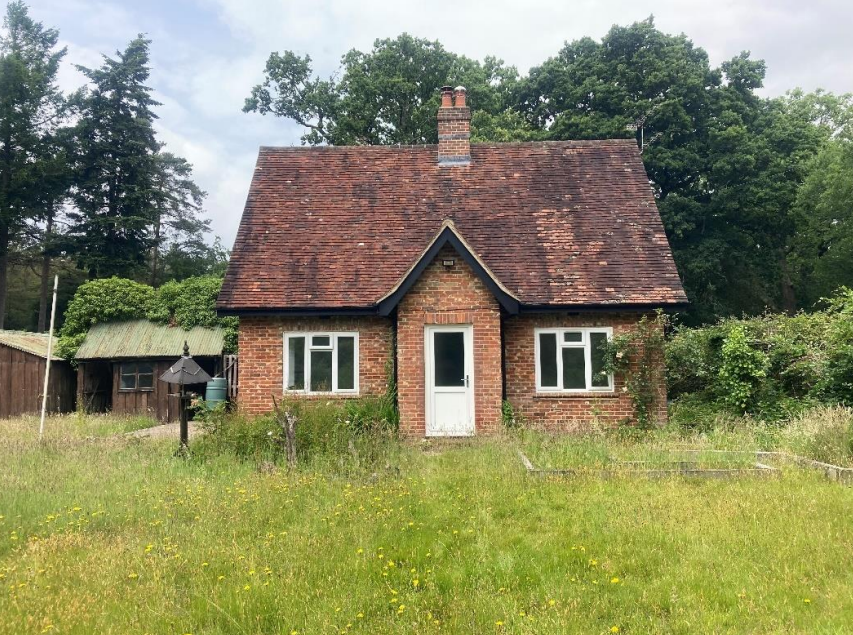At this month’s sitting of Verderers’ Court, Andrew Parry-Norton, chair of the New Forest Commoners Defence Association (CDA), delivered two presentments highlighting urgent concerns affecting the management of the Forest.
In the first presentment, Andrew addressed the increasing volume of fallen trees and timber in woodland areas, supporting a presentment at the Court the previous month from a fellow Commoner to have the debris more actively cleared.
‘The CDA acknowledges that a certain amount should be left for the benefit of the ecology,’ he said on Wednesday, 16 July. ‘But we now feel this policy has been taken to the extreme. Access for stock welfare has become difficult and dangerous.’
The second presentment focused on New Forest District Council’s roll-out of food waste bins.
‘As was predicted by the CDA, the rollout has not gone well,’ Andrew told the Court, referencing pictures and reports of donkeys prising open the caddies and consuming the contents.
He warned the problem would only worsen with the approaching pannage season, when pigs are turned out onto the Forest in autumn.
‘Urgent discussions need to take place involving all interested parties, maybe suspending the separation of the waste food from general waste until this problem is solved,’ added Andrew.
You can read the two presentments in full here
The New Forest is a living, working landscape which is rich in tradition, natural beauty and shared responsibility.
New Forest Commoners play a vital role in its care and protection which is why views are being sought on two important Public Space Protection Orders (PSPOs) that were introduced in July 2023 to reduce wildfire risks and protect the welfare of Commoners’ free-roaming animals.
These PSPOs are now due for review, and feedback is wanted to decide whether they should be extended.
What the PSPOs do
- PSPO 1: Prohibits the lighting of fires and barbecues, as well as the dropping or placing of items that could cause a fire, such as used disposable barbecues or smouldering litter, within defined areas of the Forest
- PSPO 2: Prohibits the feeding or petting of free-roaming New Forest ponies, horses, donkeys, and mules, to safeguard animal welfare and reduce risks to the public
These orders were introduced to reduce wildfire risk – especially during dry months – and support the health and welfare of livestock.
Each PSPO lasts for up to three years and they are then reviewed before a decision is made to extend them or not.
Why Commoners’ voices matter
The New Forest is a shared space, shaped by generations of Commoning so the insight of Commoners of how the two PSPOs are working on the ground is invaluable.
Whether it be positive change, concerns, or suggestions, New Forest District Council (NFDC) is after feedback to help shape the future of these protections.
How to have your say
NFDC is inviting all New Forest Commoners to take part in a short survey to help it decide whether these orders should be extended for another three years.
The feedback will directly influence how the council – along with partners The Verderers of the New Forest, Forestry England and the New Forest National Park Authority – continues to safeguard the Forest and its unique way of life.
Take the survey here
The deadline to complete the survey is midnight on Sunday, 10 August.
Chair of the New Forest Commoners’ Defence Association (CDA), Andrew Parry-Norton, has outlined how the proposed options for local government reorganisation could impact commoners.
New Forest District Council is calling on those in and around the Forest to give their feedback on the three proposals with commoners on parts of the Waterside and in Totton potentially hit in a variety of ways by the changes.
Here are Andrew’s thoughts on the issue:
‘Option one is for the New Forest to join up with the Test Valley, Winchester, a bit of east Hampshire and become what they’re going to call a Mid Hampshire District Council,’ he says.
‘Option two is that the New Forest basically is going to join up with Southampton. And so we (the New Forest] just become like an add-on to Southampton District Council.
‘Option three is to split the Waterside off, so the Forest will be divided up between Test Valley and Southampton District Council.
‘Now this won’t affect our rights as commoners – nothing will do that. But if Southampton take on the Waterside, the worrying concern would be obviously the back-up grazing.
‘Jo Ivey’s report that came out recently highlighted a lot of the problems we have with back-up grazing. So potentially would Southampton – an urban council – look after our back-up grazing? Planning could be an issue, as could representation.
‘Southampton is huge – a population of just under 300,000 – and we are going to be a very small minority. Are they going to understand our concerns of how the Forest runs and how it is so unique? There are potentially major problems.
‘My own personal view is we don’t want the Forest split. The Forest has to stay united. We’re working very hard on an agri-environmental scheme that will unite the whole Forest.
‘Let’s keep it together as one and make sure that commoners have a strong voice. We don’t want to see the Forest split, keep the Forest whole.
‘It’s your own choice and please make your own decisions on this, but I feel the Forest should stay united.’
Commoners impacted by the proposals can have their say in a survey through NFDC. You can take the survey here
Commoners with land or holdings in the Waterside and Totton areas are being urged to raise their concerns amid fears that proposed local government changes could impact their access to the New Forest.
Under the current reorganisation proposals, parts of Waterside and Totton may be transferred to a newly formed Southampton District Council. This shift raises serious concerns for commoners who rely on proximity to the Forest to exercise their grazing and other traditional rights.
If these changes go ahead, affected commoners find could themselves geographically and administratively cut off from the Forest, potentially putting generations of commoning practice at risk.
New Forest District Council (NFDC) is currently gathering feedback on the reorganisation through a survey, and commoners are being strongly encouraged to make their voices heard.
New Forest Commoners’ Defence Association (CDA) chair Andrew Parry-Norton says: ‘We at the CDA would urge anyone who may be affected by this to take the survey as soon as possible to express their views.
‘It is vital that the impact on traditional rights and access to the Forest is fully understood and taken into account during the process.’
For more information, visit the How to have your say section on the NFDC website here
Forestry England is inviting applications from active New Forest commoners to rent three properties in the Forest.
Full details of the properties and how commoners can apply for them can be found below.
Properties available
New Copse Cottage South, Beaulieu Road, Brockenhurst
A two bedroom detached house with garden and outbuilding, located within New Copse Inclosure.
More information on New Copse Cottage South
Powdermills Bungalow, Eyeworth, Fritham
A three bedroom detached bungalow located north west of Fritham, includes off road parking, large garden, stable block and small outbuilding.
More information on Powdermills Bungalow
Springwood Cottage East, Burley Lodge, Burley
A three bedroom semi-detached cottage located in Burley. Access to the property is via a Forestry England track off the Lyndhurst to Burley Road.
More information on Springwood Cottage East
All rents are below commercial rates and structured to be genuinely affordable for working commoners.
Who can apply?
You must be an active commoner, meaning:
- You own or manage livestock with registered grazing rights
- You participate regularly in Forest land management or conservation
- You can demonstrate ongoing, meaningful involvement – not just occasional or historic activity
Applications are reviewed by a dedicated panel made up of the official Verderer, an elected Verderer and a representative from Forestry England.
This ensures the process is fair and focused on sustaining commoning.
How to apply
New Forest commoners interested in applying must have the following:
- Evidence of active commoning (e.g. livestock records, grazing licences)
- References from the commoning community
- A willingness to enter a Farm Business Tenancy agreement
Visit the Forestry England New Forest Housing page to view the full listings and download application materials.
The deadline for expressions of interest in the above properties is 5pm on Tuesday, 22 July.
Andrew Parry-Norton delivered a presentment on the urgent need for a sustainable agri-environmental future for the New Forest at this month’s sitting of Verderers’ Court.
The chair of the New Forest CDA and Forest Farming Group emphasised the growing pressures facing the Forest, including diminishing government support for rural and agricultural sectors.
He underscored the essential role of commoners’ grazing in maintaining the landscape and biodiversity of the Forest, as well as the ongoing need for funding to support infrastructure and ranger services.
The Forest Farming Group, comprised of multiple organisations, is working towards securing the New Forest’s entry into a new agri-environmental scheme. The recent PA2 study, commissioned by the FFG at Defra’s request, concluded that while the Forest’s needs are clear, there was insufficient data at the time to define a suitable Forest-wide scheme.
However, the Landscape Recovery scheme has emerged as the most promising option. This government initiative, if adapted appropriately, could serve the Forest well. Andrew noted that a narrow application window could open in the near future, so the Forest must be prepared to submit a compelling bid.
He called on the Verderers to continue taking a leading role in uniting Forest organisations and shaping a shared path forward. In closing, he stressed that only through collective commitment can the Forest achieve a sustainable, resilient future that supports both its unique environment and the people who depend on it.
Read the presentment in full here
The New Forest Agricultural Show Society has announced its special showcase of cattle classes for this year.
Held annually in early July, the classes honour the vital role of grazing cattle in maintaining the unique landscape of the New Forest.
At the core of commoning is the ancient right of pasture, which allows practising commoners to graze their cattle freely across the open Forest.
The animals help control undergrowth, shaping the landscape and preserving the biodiversity of the area. Without them, the Forest would look and function very differently.
The New Forest cattle classes are open to cattle owned by registered commoners and that have been running on Forest land this year.
Judging takes place on the open Forest before the start of the New Forest Show, with awards recognising excellence in beef heifers, beef steers, and suckler cows with calves.
Trophies and awards include:
- The Hall Trophy for best beef heifer
- The Arthur & Kit Harrison Cup for best beef steer
- The Morgan Trophy for best cow and calf
Winners will receive 2025 Show memberships or tickets, and first-prize winners will be honoured during the Grand Parade on Tuesday, 29 July.
The Show itself takes place at New Park in Brockenhurst from Tuesday, 29 July to Thursday, 31 July inclusive.
For further information please contact livestock secretary Jenny Dolbear by email (jenny@newforestshow.co.uk) or head to the New Forest Show website to enter.
In his latest monthly video message to members, chair of the New Forest Commoners Defence Association, Andrew Parry-Norton, shares some key updates from across the Forest.
Among the main topics, Andrew discusses talks with New Forest District Council (NFDC) regarding food waste bins and commoners potentially receiving ‘minority’ status. He also touches on the latest progress with the Landscape Recovery bidding process, a vital opportunity for securing long-term support for sustainable land management.
Andrew highlights the importance of cattle vaccination in maintaining herd health and protecting livestock across the Forest amid thanks to the New Forest Trust for the grant it gave the CDA earlier in the year for BVD vaccinations.
Meanwhile, preparations are underway for the New Forest Show at the end of July, where the CDA will have a presence, giving members and the public a chance to learn more about commoning and its value.
Watch the full update below or on our Facebook page here
A report has been published following a survey on the extent and location of back-up land for New Forest commoners.
The survey, which was aimed at all commoners who turn animals onto the Forest and adjacent commons in 2024, sought to establish how many acres of back-up land each commoner owns or rents, and where the land is located across the parishes of the New Forest District Council area.
The research was led by Jo Ivey and has been carried out in collaboration with GeoData at Southampton University, along with the support of the Verderers of the New Forest and the New Forest CDA. The report sets out the results of the survey and uses the information included in the Verderers’ Marking Fee Register (MFR) to model the results across the commoning population.
In brief, the results highlight:
- An increased demand for suitable back-up land
- Limited availability of quality grazing options
- Concerns about affordability, long-term security, and distance of the back-up land from the Forest
- Calls for coordinated efforts to map, safeguard, and expand access to this critical resource
Jo adds in the report: ‘The results of the survey demonstrate that New Forest commoners require a considerable area of private grazing land to support their animals when they are taken off the Forest. While many commoners have their homes or holdings in the core parishes of the New Forest, many also rely on back-up land in the surrounding parishes.
‘Cattle commoning becomes increasingly difficult if the land where animals are kept over winter is isolated from the Forest. Without access to considerable areas of grazing land local to the open forest it is doubtful that many of these commoners would be able to continue to depasture their livestock on the open Forest, resulting in the rapid decline in the area’s environmental and landscape value, as well its attractiveness to the many visitors who come to the New Forest.
‘Given the pressures on grassland in the area around the National Park, recent developments in government policy pose a considerable threat to the future of the limited area of available for back-up land in the parishes that come under New Forest District Council for planning control, and therefore to commoning in the New Forest and with it, the future of the Forest itself.’
This summary of the New Forest Association’s work was written by Sarah Nield, the organisation’s new chair. The report was first published in the New Forest CDA annual review for 2024/25.
The past year, like most others in recent times, has been a busy one for the NFA.
Coupled with the range of issues that impact on the Forest, the NFA has seen a changing of the guard with John Ward, our memorable chair for the past decade, standing down and Sarah Nield moving from being secretary to becoming chair.
A change at the top often offers an opportunity to look at the management of an organisation and the NFA has been looking at its business strategy and profile.
It’s not that our core mission has changed or we want to do anything differently, it is rather that we would like to increase our profile and membership to make sure people know and hopefully support what we do.
The first step in that process has been to revert to our registered name and logo. Some CDA members, I suspect, may have always referred to us as the NFA.
We have always supported commoning and several of our projects this year have looked to commoning. For instance, Jo Ivey has been looking at the availability of back-up grazing. This is important research given that the planning authorities tell us that they find it difficult to consider the need for back-up grazing in their planning decisions given the lack of data.
We also take a keen interest in present debates over the changing financial support structure for commoning and are keenly aware that the financing of the Forest, as a whole, rests on shaky foundations that need to be stabilised.
Most of the work of the NFA is carried out by our expert committees – Planning and Transport (PTC), and Habitats and Landscape (HAL). As part of our renewed strategy, we have revived two additional committees – the Recreation Committee (RC) and the Membership and Marketing Committee (MMC).
That said our consultative council, with your chair often in attendance, continues to be a most important forum for the discussion of Forest matters. His contribution has been and continues to be invaluable, and we welcome the close working relationship between our two organisations.
HAL has concentrated on issues where it believes a difference can be made. Thus, most of its work is longer term and strategic although it is always ready to address topics of immediate concern. Questioning the adequacy of Forestry England’s environmental assessments for the food vans in certain Forest car parks being just one example.
The introduction of beavers throughout Britain is an issue that HAL has considered this year. In many cases, beavers bring benefits particularly to flood prevention.
However, the Forest is somewhat different. It already has the habitats associated with beavers and thus HAL has been working with beaver experts to identify the Forest context and what is needed to identify and manage the risks to Forest habitats including Forest grazing.
It is gratifying to see that HAL’s work, funded by the NFA, into the water quality of Forest rivers and wetlands is bearing fruit with continuing research, monitoring and lobbying now continuing with a range of partners.
The absence of an effective strategy for the management of recreation continues to give concern to the NFA. Over the past year, this became manifest in extensive, ad hoc proposals to extend the official cycle route network across the Forest.

Ponies in the New Forest
Unfortunately, the proposals were not informed by assessments of impacts on wildlife, commoning, aesthetics or the welfare of other users.
There is a problem with cycling on the Forest with our Byelaw Watches, the last conducted in the summer of 2024, showing continued widespread abuse and the lack of effective management. It is very difficult to contemplate yet more routes until those responsible demonstrate they will not just exacerbate existing problems.
The cycling debate has highlighted the fact that we still await full details of the promised spatial plans, with its associated thinking, for the allocation of recreational pressure both on the Forest and for its diversion to other green space in the vicinity. Outline proposals have been around for some time and 2025 is set as the year for their formal unveiling. In the meantime, rumours swirl.
Dovetailing with the spatial plan are local authorities’ recreational mitigation policies and the revenue they raise from contributions paid by developers when planning permission is granted. PTC and RC have been looking at this complex area.
The funds raised are expected to finance the implementation of the spatial plan and meet the cost of more rangers to control recreation. We know that aspects of these policies are tantalisingly close to fruition. Unfortunately, what is not close to seeing the light of day are attractive recreational opportunities outside the Forest boundary.
We sit with representatives of the CDA on the Camping Liaison Group. Whilst we are pleased to see improvement to campsites’ management and steps to address commoners’ liability for injury caused by commoners’ stock, concerns remain. A growing number of campsites are in unfavourable condition and are recommended for closure, whether permanently or temporarily, yet frustratingly there are still no clear plans to do so.
The PTC continues to monitor all planning applications and to make representations or objections where appropriate. They also respond to local plans and to nationwide consultations. With a change of government, these are coming thick and fast. In particular, PTC responded to the National Planning Policy Framework and is already looking to respond to other national consultations.
In this task the resources of the Campaign for National Parks have proved very useful. Given the unique Forest context, we do not always see eye to eye and do not hesitate to say so when necessary.
The Waterside always seems to be a focus of our attention on planning matters and 2024 was no different with Exxon’s carbon capture proposals. These included the threat of a pipeline across the southern part of the Forest on its way to planned carbon storage capacity off the Needles. Fortunately, the proposals were dropped at a relatively early stage but not before a good deal of opposition had been mobilised.
The Freeport and the upgrading of the A326 continue to cause concern but the ambitious Fawley Waterside development on the old power station site has been dropped at least for the time being. We wait to see what might follow.
And finally, but not least, we are very pleased to be able to announce that Sue Westwood has joined our Council where her considerable experience of the Verderers Court and commoning issues is sure to prove invaluable.
Sarah Nield – Chair, New Forest Association

Members Login
 Latest Tweets
Latest Tweets
Follow us
@realnewforest 4h
Icilibus sam quas aut eriatem nume corepta auta conet officaborem quodi corepta auta conet officaborem quodi apernat ectlpa dolorpiaecus.
@realnewforest 4h
Icilibus sam quas aut eriatem nume corepta auta conet officaborem quodi corepta auta conet officaborem quodi apernat ectlpa dolorpiaecus.
@realnewforest 4h
Icilibus sam quas aut eriatem nume corepta auta conet officaborem quodi corepta auta conet officaborem quodi apernat ectlpa dolorpiaecus.
With thanks for support from






